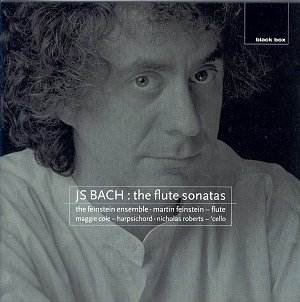|
|
Search MusicWeb Here |
|
 |
||
|
Founder:
Len Mullenger (1942-2025) Editor
in Chief:John Quinn
|
|
|
Search MusicWeb Here |
|
 |
||
|
Founder:
Len Mullenger (1942-2025) Editor
in Chief:John Quinn
|

|
Johann Sebastian BACH (1685-1750) The Flute Sonatas Partita in A minor BWV1013 (for solo flute) Sonata in B minor BWV1030 Sonata in A major BWV1032 Sonata in E minor BWV1034 Sonata in E major BWV1035 Maggie Cole, harpsichord Nicholas Roberts, cello Rec: June 2000, Potton Hall, Suffolk, England. |
| CD available for post-free online mail-order or you may download individual tracks. For some labels you can download the entire CD with a single click and make HUGE savings. The price you see is the price you pay! The full booklet notes are available on-line. |  |
|
NOTE • Click on the button and you can buy the disc or read the booklet details • You can also access each track which you may then sample or down load. • Further Information. |
|
|
Martin Feinstein takes a huge risk opening this recording with the solo flute partita BWV 1013. This is a very difficult work to play - not that the music itself calls for a virtuoso flautist, but, like Bach’s solo works for violin or cello, it calls for the subtlest manner of infusing the right emotion into the music. One does not play this music, one must live it. Unfortunately, Feinstein does not give the impression that he is living the music; it sounds like he is merely playing the notes. Not only does he take long pauses to breathe - pauses which are long enough to be disturbing - he gives the music no soul. He plays the notes, he plays the melodies, but the music does not come to life.
The final movement of the work, the Bourrée Anglaise, is the only part where he seems to be in touch with the music. Even then, however, he lacks the real vitality to give this music the emotion it deserves.
Yet all this changes when the B minor sonata for flute and harpsichord begins. Alone, Feinstein seems to be battling with nature, but supported by the harpsichord - excellently played by Maggie Cole - he focuses himself much better. It is as if he needs the structure of the accompaniment to make this music sound good. While his tone is not always perfect - which is either a result of his flute or the recording itself; he sounds shrill at times. He gives the music a much better time in these pieces where he is accompanied. Unfortunately, the flute is a bit too prominent, and the harpsichord does not get to play its appropriate role.
Nicholas Roberts’ cello has a rich deep sound, and the two final sonatas for flute and continuo benefit from this, even though, as for the flute and harpsichord sonatas, the flute is too far forward. In the faster movements of these two sonatas, there is a nice interplay among the musicians, but this falls away in the slow movements.
There is good and less good on this disc. While the solo flute partita is disappointing, the other works are well played. The lack of balance among the instruments detracts a little from the music, and the musicians do not always sound very tight. This is far from the best recording of these works, though better than many.
|
Sonata in
B Minor, Andante Sonata
in A Major, BWV1032 Sonata
in E Minor, BWV 1034 - Sonata
in E Major, BWV1035 Get a free QuickTime download here |
|
ADDITIONAL INFORMATION •
You can sample only 30 seconds (or 15% if that is longer) of a given track. Select from the View tracks list. Each sample will normally start from the beginning but you can drag the slider to any position before pressing play. • PLEASE NOTE: If you are behind a firewall and the sound is prematurely terminated you may need to register Ludwig as a trusted source with your firewall software.
•You will need Quicktime to hear sound samples. Get a free Quicktime download here • If you cannot see the "Sample All Tracks" button you need to download Flash from here.
|
|
|
Return to Index |